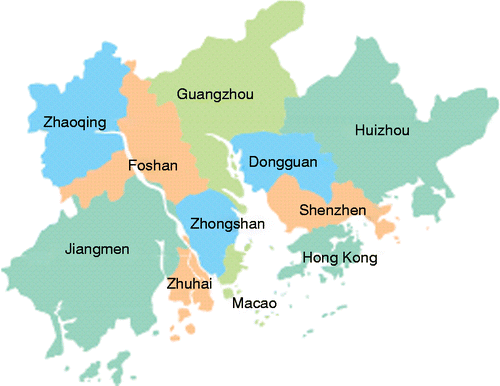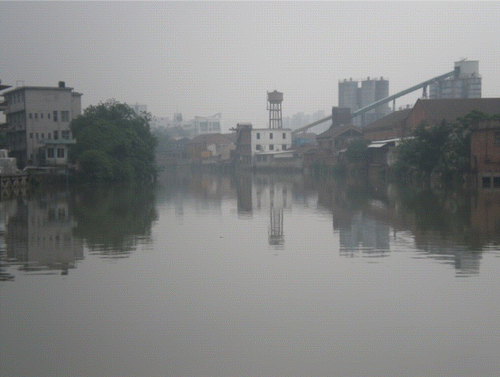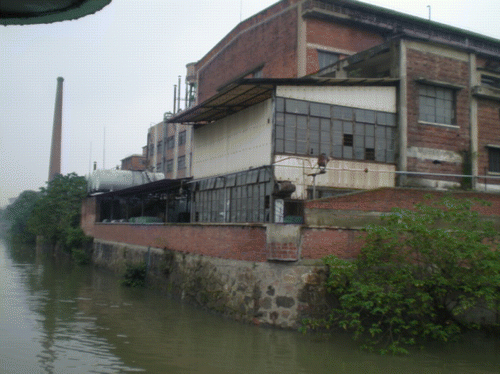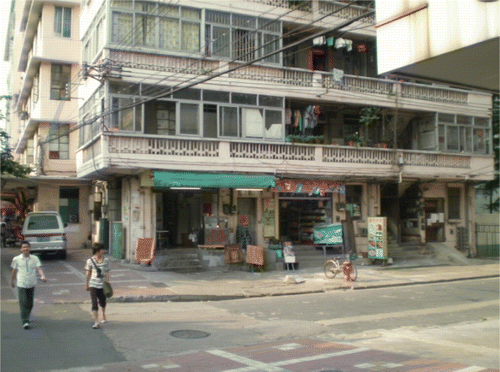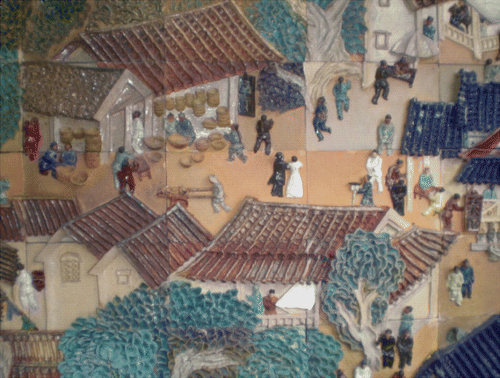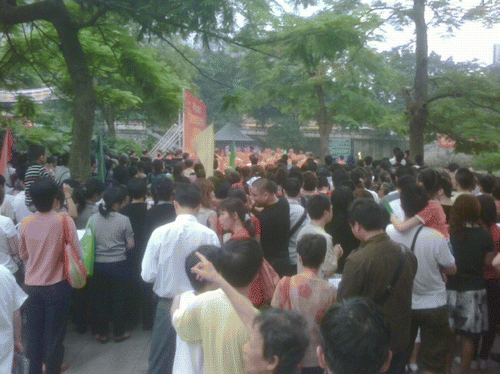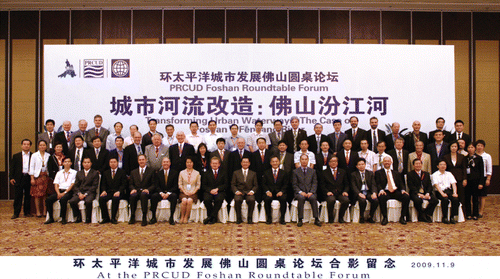Abstract
Human settlements have long been located on rivers, and the relationship of the place to the river functions as a deep reflection of its historical, cultural, and socio-economic traditions. This paper explores urban river revitalization in contemporary China, focusing particularly on ongoing efforts to clean up Foshan's polluted Fenjiang River. The research shows that the traditional cultural status of the waterway, which is known as the “Mother River” of Foshan, plays a paradoxically pivotal role in the project to modernize it. Interacting in complex ways with domestic and international political concerns, and popular media and internet technologies, the cultural status of the river has helped to determine both the type of environmental movement that has emerged in its defence, and the community of interests that serves as a proxy for civil society in that movement. Ultimately, this paper argues that the unique configuration of institutions and actors engaged in the Fenjiang River restoration project are emblematic of a new type of “environmentalism with Chinese characteristics.”
Keywords:
Introduction
As a general rule, the relationship between human settlements and their respective rivers may be best understood in a broad historical and socio-economic context. The manner in which societies interact with “their” rivers tells us as much or more about themselves as it does about the rivers per se. This paper builds upon this premise to examine the societal context of urban river transformation in contemporary urban China, using Foshan's Fenjiang River as a case in point. For a variety of reasons that we shall explore in some depth, the Fenjiang River is the locus for a major “remediation” effort, and so the river waters are reflective of the ongoing socio-economic transformation that continues to pervade urban settlements throughout so much of China. Putting such river remediation projects in context also has a practical aim here, namely discerning which modes of professional planning intervention are likely to be most effective in that context—a point that we also seek to establish using Foshan as a case study.
It is no coincidence that many cities today have rivers running through them, as the founding of those settlements can often be traced back directly to the locational advantages of being situated along the river banks. Thus, from the outset, there has often been a strong association between the very existence and identity of a human settlement and the presence of its river. Woodgate and Redclift (Citation1998) refer to this phenomenon as one of “socioenvironmental relations” or the “co-evolution between society and nature” (p. 13): “Once an ecosystem has been transformed by human activities it is assigned functions relating to the fulfilment of human needs concerning places to live and work, the supply of raw materials and the assimilation of wastes…This gives the boundaries of transformed systems obvious socioeconomic dimensions” (p. 9).
This underlying premise is further expounded upon here in Table , which provides an encapsulated view of the co-evolution of urban rivers and their respective human settlements during successive historical eras. According to this perspective, rivers in the pre-industrial era were primarily viewed in ecological terms as a direct source of sustenance for human settlements. In traditional river-based societies, sustainable practices were inculcated and reinforced through cultural practices and rituals.
Table 1. Urban rivers in a broad historical socio-economic context
This began to change during the early industrial era in the UK and the USA. As highly mechanized modes of production were introduced, factories were often sited on riverfront locations. These sites served as convenient sources of water as an input to production, hydropower, goods transport, and discharge of effluents. Rivers were viewed in frankly utilitarian terms, and land uses along riverways were allocated, by means of land markets and land-use regulations, in basic accordance with this economic logic. This pattern was replicated around the world as the early capitalist mode of production extended its reach. Eventually, as the dominant technologies of production evolved in the modern era, especially with the introduction of ubiquitous roadways for automotive transport, the locational advantages of these early urban industrial riverfronts became obsolete and those outmoded areas fell increasingly into economic and physical decline.
In the USA and elsewhere, an emergent post-industrial society has been characterized in part by an increasingly assertive “demand side” or consumer-oriented culture, including an ever more assertive environmental movement that places emphasis on the potential aesthetic and recreational values of urban riverfronts. This pattern has been replicated countless times worldwide, and has ushered in an era where cities in all corners of the globe have been “re-inventing” their riverfronts as amenity-laden loci for people-centered activities such as recreation, aesthetic viewing, and leisure. Many of these transformations are iconic in nature, including London's pedestrian Millennium Bridge over the Thames, the San Antonio riverfront, Singapore's Clark Quay and Boat Quay, and Seoul's Cheonggyecheon River. They are iconic in the sense that they signal not just a change in land (and water) use, but a change in “attitude” as well. This attitudinal change can be seen also in the pro-active role of civil society initiatives, such as “Friends of the Los Angeles River”, in prompting public awareness and civic action where cash-strapped governmental agencies may be wanting in resources to do so. Deft politicians can sometimes do well by positioning themselves strategically with respect to these shifting currents. San Antonio's then-Mayor Henry Cisneros rose to national prominence in large measure because of such populist considerations. Likewise, President Lee Myung-buk of Korea was able to soften his image as the former head of a major Korean corporate conglomerate (“choebol”) by making the enormously popular Cheonggyecheon River restoration project the centrepiece of his recent term as Mayor of Seoul.
Thus, we may take as a fundamental premise that the relationship between a city and its riverways is reflective of the broader socio-economic context within which it is embedded. It follows from this that urban rivers in China may represent a special case, just as Chinese urbanization itself is quite distinctive and has been the focus of a great deal of scholarly attention. China is unique in several regards that are pertinent to this study. In particular, China is undergoing no fewer than three dramatic and inter-related transformations simultaneously: (i) from a relatively impoverished Third World country to a major force in global economic affairs; (ii) from a predominantly rural society to an increasingly urbanized one, and (iii) from an ideologically rigid communist society with state ownership and oversight of the means of production to a unique hybrid model incorporating a mix of pervasive market structures intermingled with hierarchical political structures. What might be the relationship, then, of cities and their respective rivers in this setting? How are these currents of change in China manifested in the rivers running through its cities?
To address this question, this paper examines in some detail a case study of the Fenjiang River in Foshan, China. The Fenjiang River is a minor branch within the exceedingly complex maze of interconnected inland waterways located within the Pearl River delta in Guangdong province, southeast China. It is, however, known as the “Mother River” of Foshan, a municipality that is relatively little known outside China despite its population of 5.8 million people and its high per capita GDP,Footnote 1 perhaps in part because it is eclipsed by its immediate neighbor Guangzhou, and by the Special Administrative Region of Hong Kong, located further downstream at the mouth of the Pearl River as it lets out to the South China Sea. Foshan is not selected here as a case study because it is necessarily viewed as somehow typical or representative of Chinese cities. Instead, it is seen here as more of a leading edge and possible portent of ensuing change, just as one might choose to examine San Antonio's riverfront or Seoul's Cheonggyecheon project for similar reasons. They represent exceptional cases that may have important lessons for others,Footnote2 and that are indicative of what is likely to be an emergent class of cities.
The same is true of Foshan.Footnote3 Elizabeth Economy (Citation2004, p. 117) finds that cities in China with better environmental track records tend to be characterized by three conditions: (i) a mayor who is environmentally pro-active so that there is committed leadership; (ii) relatively high income levels compared to other localities, and (iii) a city that is tightly integrated into the international community. As we shall see below, Foshan readily meets all three conditions. Moreover, it is located in the heart of the Pearl River delta (PRD) region, which for decades has been on the leading edge of economic and other reforms in China. Of special relevance to this study, the Fenjiang River has been the focus of an ambitious restoration project by municipal officials there. The importance attached by Foshan Municipality to this initiative is underlined by the formation of the Foshan Fenjiang River Comprehensive Remediation Office, reporting directly to an up-and-coming vice mayor and bringing together key staff from engineering, environmental, finance and other bureaus within the municipality to provide a dedicated and coordinated effort. With the blessing of relevant provincial and national government authorities, Foshan has also engaged the World Bank and other international development agencies who have made substantial project loans available in support of specific Fenjiang River remediation efforts. Foshan Municipality has also sought to engage a wider international community of experts, again with explicit approvals and endorsements from senior government authorities, in addressing a broad array of technical and strategic issues regarding urban river transformation.
The question arises in this context of whether and how the unique qualities of China's overall parallel transformations, described above, are reflected in the more specific approach to urban river transformation we see unfolding in Foshan. There are several aspects to this broader question. One aspect concerns the overall approach that Foshan brings to its urban river relationship. Is it akin to the utilitarian view of rivers that we used to characterize an industrial era approach, or is it more akin to the emerging aesthetic view of rivers that is typical of post-industrial societies? Or, is Foshan's stance something more reflective of China's unique position in terms of these grand macro-developmental trajectories? Another set of questions concerns the manner in which Foshan sets about implementing the vision that derives from its stance. How are the governing institutions in Foshan set to respond to a range of socio-economic, financial, economic, civil, and cultural issues that are intrinsic to any large-scale urban transformation? These questions echo the call by CitationElizabeth Bird who writes that “We need histories of environmental problems that examine the social relations, structural conditions, cultural myths, metaphors, and ethical presuppositions that constitute the social negotiations with nature that contribute to those problems” (1987, p. 262).
The paper sets out to answer these and related questions through a variety of means. One is through direct engagement, as the author has been working in close collaboration with Foshan municipal officials over a two-year period, addressing issues of Fenjiang River revitalization, and helping to organize and coordinate the participation of dozens of additional foreign advisers as well. This active engagement has provided a unique vantage point for gaining first-hand insights into the motivations and methods of Foshan local officials. The project has also generated a wealth of reports and other documents both by Foshan Municipality and international agencies that provide ample insight into the issues being grappled with. These direct observations are then placed in the context of an extensive literature on urbanization in China, as well as on the emergence of environmental non-governmental organizations that represent an important development in China's civil society. The paper proceeds in several parts. The next section provides a sketch of Foshan, relating its evolving relationship with the Fenjiang River to a backdrop of three decades of profound socio-economic transformation in the Pearl River delta area. The subsequent section documents key aspects of the current Fenjiang River revitalization programme and its links to related urban development initiatives. Those set the stage for examining the cultural dimensions of the project, as well as the role of civil society (particularly the role of environmental NGOs). A concluding section recapitulates lessons learned from the Foshan Fenjiang River restoration project, and it recasts this case study in a broader perspective.
A key finding of this research is that the deep well of Chinese traditional values proves to be an important means by which municipal leaders in Foshan are able to approach the unique challenges of implementing urban river restoration projects there. In part, these traditional values serve as a kind of proxy for a nascent civil society. Insofar as there is no fully autonomous civil discourse on the future of the Fenjiang River basin, local government officials are directing their discourse to the implicit community defined by common adherence to these traditional values. The incongruity here is that traditional culture becomes a key to understanding how such projects are conceptualized and embedded within China's modernization project. This is also consistent with the “blurring of boundaries and amorphous nature of the environmental sphere in China” (Sullivan & Xie, Citation2009, p. 430). It is one thing to install infrastructure works to clean up a smelly, foul and polluted urban waterway as examples of modernization and technological progress. It is quite another thing to mobilize an urban population to rally around the cause of the “Mother River” of Foshan (though the practical result may be the same). Although the comprehensive issues that must be addressed in Foshan are not so different from those that arise in most established urban settings throughout the world, the “social codes” that are invoked in Foshan to mobilize ideas, commitment and resources are deeply embedded in traditional values. As discussed in more detail later in the paper, the social codes referred to here include the use of centuries-old ceremonial rites such as dragon-boat racing and the releasing of fishes by Buddhist monks as a means of generating popular support for river restoration projects. As Woodgate and Redclift (Citation1998, p. 7) argue, “We must move beyond the position where nature is viewed as either the material conditions of our existence, or as no more than a set of culturally generated symbols. We must begin to accept nature as both.” In the context of Foshan, we see this recognition being applied quite self-consciously by a local government that seeks to advance the environmental dimensions of its modernization project by evoking deep-seated traditions surrounding the “Mother River” of Foshan. This is part and parcel of what Peter Ho (Citation2001) refers to as the “greening of the state”. It is, in effect, environmentalism with Chinese characteristics.
Fenjiang: the “Mother River” of Foshan
Foshan assumed its current name (![]() , meaning “Buddha Mountain”) in 628 AD, during the early Tang Dynasty, following the discovery and excavation of three Buddhist statues there. For many centuries, however, the settlement had been known in its prior incarnation as Jihua Village for its pottery production, an early antecedent of the ceramics industry that is today one of the hallmarks of Foshan. The area is ideally suited to rice and other agricultural production, with an abundance of water from local riverways flooding low-lying plains during the steamy summer months. For centuries now, the Fenjiang River has been commonly referred to locally as the “Mother River” of Foshan, in recognition of and homage to its life-giving qualities. The word “river” really does not do justice to the web-like structure of interlinked waterways comprising the Pearl River. As a hydrological system this riverine network is extremely complex, with water flowing in either direction along many of its segments depending upon the relative strengths of contributing branches of the Pearl River, and also on tidal effects pushing up-river from the South China Sea. Over the centuries, rhythms of daily and seasonal life were closely tied to the currents of these waterways. Waterborne navigation required careful attention to such flows, as did irrigation of paddy fields.
, meaning “Buddha Mountain”) in 628 AD, during the early Tang Dynasty, following the discovery and excavation of three Buddhist statues there. For many centuries, however, the settlement had been known in its prior incarnation as Jihua Village for its pottery production, an early antecedent of the ceramics industry that is today one of the hallmarks of Foshan. The area is ideally suited to rice and other agricultural production, with an abundance of water from local riverways flooding low-lying plains during the steamy summer months. For centuries now, the Fenjiang River has been commonly referred to locally as the “Mother River” of Foshan, in recognition of and homage to its life-giving qualities. The word “river” really does not do justice to the web-like structure of interlinked waterways comprising the Pearl River. As a hydrological system this riverine network is extremely complex, with water flowing in either direction along many of its segments depending upon the relative strengths of contributing branches of the Pearl River, and also on tidal effects pushing up-river from the South China Sea. Over the centuries, rhythms of daily and seasonal life were closely tied to the currents of these waterways. Waterborne navigation required careful attention to such flows, as did irrigation of paddy fields.
The Fenjiang River was an important influencingFootnote4 factor in the establishment of Foshan well over one thousand years ago, since by the Tang Dynasty it was known as a prosperous commercial production and trading centre (Foshan, Citation2009). Foshan's reputation continued to grow within China during later dynasties, as it received various instances of official recognition as one of the country's pre-eminent commercial centers. Continuing through the Republic of China period during the first half of the twentieth century, the Fenjiang River has been described as the “primary link between Foshan and the outside world.” The Mother River was more than just an artery, as is evident in this description: “The river was lined by shops and busy streets and enjoyed coming commerce and trade and rich architectural and cultural heritage. In a sense, the Fenjiang River Basin culture is an epitome of the Foshan culture” (Foshan, Citation2009, vol. IV, p. 1).
This close, almost intimate relationship between rivers and their attendant human settlements is a tradition that is steeped in traditional Chinese culture. Taoism, in particular, emphasizes the importance of harmony between humankind and nature. Tao refers to “the way” or “the path”, and conformance to the natural world is an intrinsic element of the path to enlightenment. The popular practice of feng shui (![]() , literally “wind water”) is perhaps the best known contemporary expression of this philosophical mindset. Mary Evelyn Tucker (Citation1991) argues that it is not only Taoism that provides an undergirding for a reverence of nature in Chinese culture. She argues that it is fully consistent also with two fundamental aspects of a neo-Confucian perspective; one being its “naturalistic cosmology” and the second being its search for an “ethics of self-cultivation.” Both aspects of neo-Confucianism speak from what Tucker terms an “anthropocentric” rather than an “anthropocentric” view of humankind's place in the universe (p. 57). This close relationship between human settlements and their natural river settings is also reflected in traditional Chinese architectural practice, as evoked, for example, in the “Town of Rivers” painting (see Figure ) by Niu Zhiye, a contemporary artist working in a classical style. In traditional Chinese landscape paintings, artists “refrained from positioning people at the center of their paintings, in order to counter the notion of man at the center of the universe” (Economy, Citation2004, p. 29).
, literally “wind water”) is perhaps the best known contemporary expression of this philosophical mindset. Mary Evelyn Tucker (Citation1991) argues that it is not only Taoism that provides an undergirding for a reverence of nature in Chinese culture. She argues that it is fully consistent also with two fundamental aspects of a neo-Confucian perspective; one being its “naturalistic cosmology” and the second being its search for an “ethics of self-cultivation.” Both aspects of neo-Confucianism speak from what Tucker terms an “anthropocentric” rather than an “anthropocentric” view of humankind's place in the universe (p. 57). This close relationship between human settlements and their natural river settings is also reflected in traditional Chinese architectural practice, as evoked, for example, in the “Town of Rivers” painting (see Figure ) by Niu Zhiye, a contemporary artist working in a classical style. In traditional Chinese landscape paintings, artists “refrained from positioning people at the center of their paintings, in order to counter the notion of man at the center of the universe” (Economy, Citation2004, p. 29).
Figure 1 “Town of Rivers”, by Niu Zhiye. Source: http://www.nsjd.com, with permission of the artist.

The initiation of China's Open Door policy in 1979 and deepening reforms over the three subsequent decades have ushered in dramatic changes in virtually all aspects of life in China. These changes have been wrought by the three-fold transformation discussed at the outset of this paper: rapid economic growth, large-scale urbanization, and radical institutional change. The Pearl River delta region has been at the leading edge of all of these changes, and so the transformation is more deep-seated in this region than almost anywhere else in the country. As shown in Figure , Foshan is situated at the heart of this area, near the apex of the Pearl River estuary. The extent of urbanization in the delta over this period is illustrated dramatically by the satellite images captured in Figure , which show that the entire landscape has been transformed by urbanization. As this might suggest, Foshan generally, and the Fenjiang River basin in particular, has seen a marked rise in population. In 1980 the total population of the basin was 408,800, 43.9% of whom were urban dwellers. By 2006, the Fenjiang River Basin was home to 1.42 million inhabitants, 93.6% of whom were urban. Foshan Municipality as a whole is much larger still, with a population of 5.79 million in 2006. Of these, 3.55 million people were registered residents, indicating that 2.24 million inhabitants of of Foshan were part of a large “floating population” of internal migrants in China whose official place of residence (hukou) is elsewhere. This, too, is typical of the pattern one finds throughout the Pearl River delta region, as its burgeoning economic growth has attracted workers from all corners.
Figure 3 Urbanization in the Pearl River Delta; 1979, 2003. Source: http://earthobservatory.nasa.gov/, a government document.
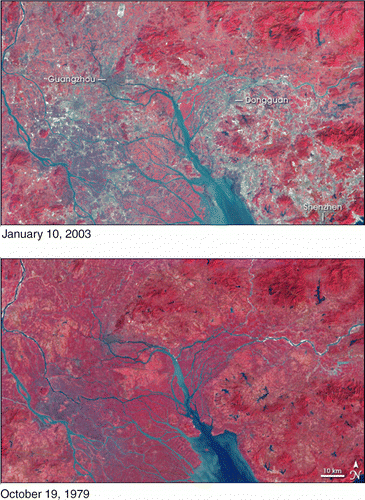
Concomitant with this urbanization, there has been a dramatic economic transformation. GDP for the region grew from a mere US$8 billion in 1980 to more than US$89 billion in 2000, increasing further to US$269 billion by 2006. As such it now constitutes what would be the world's eleventh largest economy were it a separate nation. (Enright & Scott, Citation2007). This rapid urbanization has been accompanied by an equally dramatic increase in industrialization and economic output. Foshan now produces 15% of the global output of cameras and 40% of the world's microwave ovens (World Bank, 2007, p. 27). By 2006, Foshan's GDP was remimbi (RMB) 292.7 billion, a 19.3% increase from just one year earlier. Of this total, secondary industries accounted for 62.9%, compared to 34.5% for tertiary industries and a meager 2.6% for agriculture and other primary sector industries (Foshan, Citation2009, vol. III, p. 8). While there is clearly a strong correlation between urbanization and industrialization here, George Lin (Citation2001) cautions that the chain of causality is not always as straightforward as it might appear. During the 1980s and early 1990s in particular, much of the initial industrialization was to be found in the interstices between urban centers. This rural industrialization reflected the promotion of town and village enterprises (TVEs) during this period as a means of raising living standards in the countryside. During the past decade or so, however, this has been changing through internal migration from rural to urban areas, as well as by means of systematic expansion of urban boundaries (Shen et al., Citation2002; Heikkila, Citation2007).
Notwithstanding such caveats, there is general agreement that urbanization has been an important engine for economic growth in China. Indeed, this has been a central premise of policies advocated by the World Bank (see, for example, Yusuf & Nabeshima, Citation2008). In the Pearl River Delta, the dual processes of economic transformation and urbanization were further reinforced by the Open Door policies that invited foreign direct investment. This is a part of China that has historically been more open to foreign interchange, and has been a major source of out-migration from China. Moreover, familial ties to Hong Kong and beyond also helped to channel the initial tranches of foreign capital inflows into this region.
A direct and unfortunate impact of economic growth and urbanization has been extensive water pollution within the entire Pearl River system. Addressing this issue in the context of China as a whole, Shalizi (Citation2008, pp. 162–163) reports that half of all water pollution is caused by non-point sources in rural areas (many of which are proximate to urban areas) while the remaining half derives from discharges of industrial and municipal wastewater and the leaching of pollutants from solid waste disposal sites. In the case of the Foshan River, the waterway basin in 2006 produced 160.9 million m3 of domestic sewerage and 105.5 million m3 of industrial wastewater (Foshan, Citation2009, vol. II, pp. 1, 4). The Fenjiang River Basin area itself is criss-crossed by smaller creeks, many of which have become open sewers discharging into the river. This problem is exacerbated by the bi-directional flow of the Fenjiang River which moves the wastewater sluggishly back and forth along this river segment, leading to eventual in situ silting, rather than flushing of the waste downstream. The situation is described in rather unflinching terms by Foshan municipal officials themselves:
The Foshan Waterway Basin is home to a large range of heavily polluting industries, including textile printing and dyeing, aluminum materials, paper making, chemicals and plastics, leather, electroplating, machinery building, food processing, glass and porcelain, and pharmaceuticals. These industries consume large amounts of resources and energy and are prone to pollution…Heavy polluting enterprises are most[ly] located along the river…Some enterprises do not even have wastewater or sewage treatment facilities, and certain enterprises which do have such facilities are not operating them in accordance with the requirements. Due to insufficient environmental law enforcement, supervision and administration capabilities and lax prosecution of environmental violations, illegal discharge of wastewater which has not been treated or has failed to meet the relevant standards after treatment remains widespread, exacerbating the deterioration of the water environment…What's more, solid waste is not properly disposed of. For example, only a tiny proportion of the feces in the septic tanks is converted into resources…and the bulk of the feces is piled near the creeks of the Foshan Waterway without proper treatment and flows into the water body with the runoff.” (Foshan, Citation2009, vol. II, pp. 30–32)
Fenjiang River Restoration Project
It is the situation described above that motivates the Fenjiang River restoration project, a key element of which is funded through World Bank (WB) loans.Footnote5 As described in the Bank's appraisal document, the development objective “is to reduce water pollution in the Pearl River system originating from Foshan and Jiangmen municipalities through a package of key initiatives, including wastewater treatment and sludge disposal, water quality monitoring, sediment removal from waterways, and flood protection and river embankment improvements.” (WB, 2007, p. 6). The project is seen in rather ambitious terms by both the Bank and the Guangdong provincial government, both of which aspire to have the PRD region seen as a model for environmental protection in China (p. 17).
Broadly speaking, there are two complementary approaches to ecological restoration in the context of urban river revitalization. One is to circumvent or mitigate the flow of polluting materials into the river system by intervening with infrastructure improvements that capture, divert, and/or treat the waste. A complementary approach is to alter the character of land-use activities within the river basin so as to minimize the production of waste at its source. Both approaches are operative in the case of Foshan's Fenjiang River restoration project, with the World Bank project focused primarily on the financing of infrastructure improvements. In part, this entails the construction of interceptors along river embankments so that wastewater can be diverted with the aid of pumping stations to nearby treatment plants, some of which are also constructed or upgraded through project funds. Dredging is also underway along 34 km of the waterway, with an aim of removing toxic sludge that has accumulated over the past decades and that impedes the natural flow of the river system. There are also some interesting interventions whereby certain types of vegetation are introduced into the waterway for purposes of aeration and oxygenation (Foshan, Citation2009, vol. II).
Of at least equal importance to such infrastructure-based interventions is the complementary approach of altering the character of industrial and residential land-use activities above ground within the Fenjiang River Basin. This is a major undertaking. The map in Figure identifies key enterprises generating industrial pollution in the area, along with the placement of sewerage treatment plans. For polluting industries, three basic options are being pursued in parallel by the municipality as it tries to persuade firms to (i) upgrade their facilities, (ii) relocate elsewhere or (iii) shut down operations. In most cases upgrading is not economically viable, as the factories themselves are often obsolete (see Figures and ), and the necessary upgrades are not as effective when undertaken on a piecemeal basis. Those enterprises that remain in business are typically relocated to industrial parks located throughout the city, where suitable infrastructure is in place and where other agglomeration economies may be enjoyed.Footnote6 This process can be subject to very intensive negotiations between Foshan municipal officials and affected stakeholders. The number of affected parties is too large, and the process too opaque, to explore here in any detail how such negotiations unfold, and in particular, how they might differ from those of western counterparts.
Figure 4 Map of key polluting industries. Source: Foshan (2009, vol. II), with permission of the municipality.
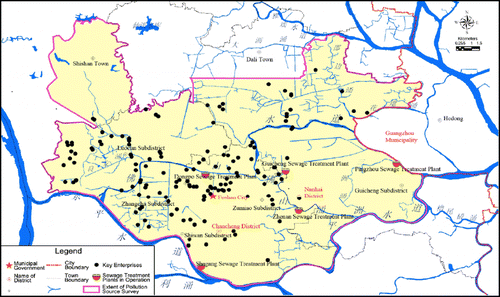
What is clear, however, is that negotiations over land use in Foshan and elsewhere in China do not readily conform to any caricature one might be tempted to draw of an authoritarian government that can undertake sweeping change simply by fiat. Land-use law is a work in progress in China, as are many key institutions guiding China's transformation. Although all land in China is still owned by the state, there are active markets in the exchange of land-use rights, especially in urban areas. National level legal reforms such as the Land Administrative Law of 1986 and an amended version passed in 1998 established the legal principle of land-use rights that were enforceable in the courts, and (in principle) proscribed the use of eminent domain, thus providing protection from unreasonable seizure by state agencies without fair compensation (Ding, Citation2007). Unjust land expropriation has been an issue in China especially along the urban–rural fringe where local government officials seek to acquire urban land through “administrative readjustment” of rural land, and this has prompted additional reforms such as the 2003 rural land contracting law (Deininger & Jin, Citation2009). Some of the same issues arise within urban areas, as the limits of eminent domain are tested in practice.Footnote7
In addition to industrial land uses, Foshan Municipality must also contend with mixed residential/commercial land uses within the Fenjiang River Basin area that are another major source of pollution. This is an older part of the city where one finds different vintages and scales of mixed residential and commercial complexes catering to various socio-economic classes (Figures and ). The newer establishments are more likely to have reliable connections to municipal wastewater lines, and so the area as a whole improves incrementally as older units are replaced by newer ones. Most residents in these complexes are registered residents, as those without Foshan hukou typically reside in dormitory-like structures that are provided by their employers. Thus, as polluting firms are relocated to upgraded industrial clusters throughout the area, it is likely that their respective employee residence facilities will be upgraded also.
Although the Fenjiang River is the first point of reference for this comprehensive remediation project, it quickly becomes apparent upon closer inspection that this is really a project that aims to guide the socio-economic transformation of the heart of Foshan itself. Cleaning the river becomes a catalyst for reinventing the heart of the city. This is the challenge for Foshan: to articulate a realistic, compelling, and persuasive vision for the Fenjiang River Basin that might guide investors to produce market outcomes that offer enduring value for all stakeholders. Can it find a single coherent voice with which to articulate the diverse aspirations of multitudes? The key to responding to such a challenge may be culture: not only is culture in and of itself a kind of synthesis of many voices into a rich coherency, it is also the basis for many societal and individual values, and value is the fundamental driver of markets, including land markets.
The Cultural Context of Urban River Restoration in Foshan
It has already been noted that Foshan's early existence was centered on the Fenjiang River. It should come as no surprise, then, that this “Mother River” should also figure prominently in the native culture of the place. Inevitably, this raises a dilemma – if the cultural heritage of Foshan is bound up so closely to the Fenjiang River, what happens to that cultural heritage when the river itself is transformed? Is it possible to retain the essence of the traditional relationship between people and river in a modern era, or is that tradition necessarily antiquated? A simple metaphor may be instructive. Any child may love its mother. In later years that love and respect continues in essence, but the nature of the relationship changes in fundamental ways as the child grows and matures into adulthood. Likewise, there may be a possibility for the people of Foshan to maintain their deep bonds with their Mother River even as Foshan itself grows and modernizes. Bourdieu (Citation2000) refers broadly to such “enduring dispositions” as “habitus”, and that is indeed what is at stake here. Ultimately, habitus in this context refers to the identity and sense of place in Foshan, and the role of the Mother River in the social construction of that identity. This helps to express the challenge in more operational terms. To what extent could the Fenjiang River be positioned to reassert its “life-giving qualities” in ways that might draw upon the past while building towards the future? In some cases the links to the past can be quite explicit and self-conscious.
A good example of this is the resumption in 2009, after a 26-year hiatus due to foul-smelling water, of the annual dragon-boat race along the river (see Figure ). For this event 150,000 people lined the river banks, which not only connected residents in a vital and immediate way to the river, but also provided an opportunity to enhance general awareness of environmental values. There are additional ways of linking living cultural heritage to river remediation objectives. In the context of Hong Kong's Kai Tak River restoration project, Wallace Chang (Citation2009) advocates the introduction of public art spaces as a means to restore a more vibrant human landscape along what was previously regarded as a mere “nullah”.Footnote8 A similar strategy of emphasizing culturally based activities has been advocated for in the case of Foshan (Yee, 2010), and the ceramics industry is a case in point (Figure ). In past decades, as the traditional craft orientation of ceramics production was superseded by a large-scale industrial mode of production, the latter became a major source of pollution as vast quantities of dyes and other industrial byproducts were released into the river. Those factories are now being removed from the riverfront and relocated to new industrial parks, and so an opportunity emerges to combine pedestrian oriented riverfronts with retail outlets for ceramics and other crafts. This exemplifies the more general principle by which the life-enhancing habitus of the Fenjiang River may be reinvented anew.
Figure 9 Ceremony marking resumption of annual dragon-boat race along the Fenjiang River. Source: E.J. Heikkila.
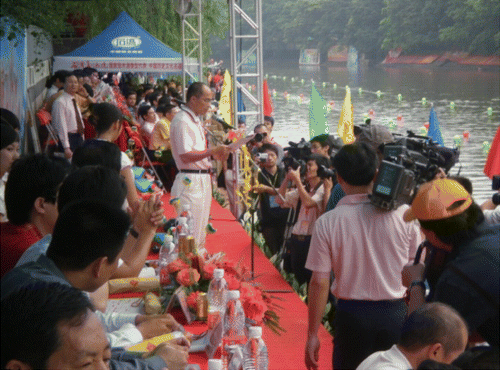
There is ample evidence of a deep emotive core connection between the current residents of Foshan and the Fenjiang River. This is the very essence of living culture, and there is no reason not to draw upon it for inspiration and guidance in preparing a land-use plan for a revitalized urban river basin. The following passage, taken directly from a professional report produced by the Fenjiang River Comprehensive Remediation Office, is almost haunting in its forlorn evocation of the dignity and purity of Foshan's Mother River:
Gone are the memories of the old hometowns. The Fenjiang River, the “Mother River” of Foshan, has embodied the endless feelings and sensation of the old city. But now, endowed with the dignity of “Mother River”, the river should not simply be restored to the scene of “a flowing stream”…With clean water and beautiful scenery on the banks, our mother river will win back its dignity. (Foshan, Citation2009, vol. I, pp. 32–33)
It is clear that, at least at some level, this remediation project is about much more than water quality; it is about recreating (or perhaps recapturing) some (lost) sense of place.
The Role of Civil Society
Although the first environmental non-governmental organization (ENGO) in China was founded relatively recently, the sector has grown rapidly in subsequent yearsFootnote9 and the role of civil society in environmental issues in China has attracted considerable attention from scholars. Several issues have been addressed by this literature. Some bemoan the perceived lack of a civil society. As Lucien Pye (Citation1999, p. 776) puts it: “The mystery in Asia is why societies with such pronounced norms of civility and respectable levels of social capital have had such weak civil societies.” Footnote10 Elizabeth Perry (Citation1994, p. 709) argues that the very concept of civil society is a social science construct that was conceived initially to examine the emergence and transformation of European capitalism, and has questionable applicability in the context of China, where the underlying historical conditions are so distinctive. In the context of environmental issues, Stalley and Yang (Citation2006) point to two divergent views of the role of ENGOs in China. On the one hand, observers such as Elizabeth Economy (Citation2004) perceive the growing environmental movement as a kind of leading edge for more broad-based democratic reforms, with some looking to the west (including eastern Europe), where environmental issues are often framed in terms of “contentious politics” (Tarrow, 1998; Stalley & Yang, Citation2006) as a hopeful precedent in this regard. Others would argue that the environmental movement in China is embedded within a social and historical context that belies any would-be parallels with the west. Peter Ho (Citation2001) points to two factors that have caused environmentalism in China to evolve in a notably non-contentious manner: “first, the ‘greening’ of the state…and second, the national government's alternating politics of tolerance and strict control of civil organizations.” As Economy (Citation2004) has shown, the civil environmental movement in China grew from the first National Conference on Environmental Protection, organized by the then-Premier Zhou Enlai in 1973. It increasingly participated in international conferences on environmental issues, culminating in the Rio conference of 1992, where China's lack of ENGOs was a notable source of embarrassment for some senior Chinese leaders. It was shortly afterwards that China's first ENGO, Friends of Nature, was established in 1994. This progression was in parallel with other sweeping reforms over the same period, and reflected recognition by the Chinese leadership that the government sector could not tackle environmental issues in isolation (Stalley & Yang, Citation2006).
Guobing Yang (Citation2005) adopts a field perspective to analyze the dynamics of these developments, as depicted in Figure . ENGOs and related actors in the environmental movement are interposed between structural changes in the broad political field and concomitant changes in the media, international NGOs (INGOs), and the Internet. The field perspective ascribes elements of both structure and agency to those who operate within these fields. It is in this context that Yang refers to the “boundary spanning” activities of ENGOs in China, which defy attempts to draw a sharp dichotomy between state and civil society.
Figure 11 A field perspective of ENGOs in China. Source: Adapted from Guobing Yang (Citation2005).
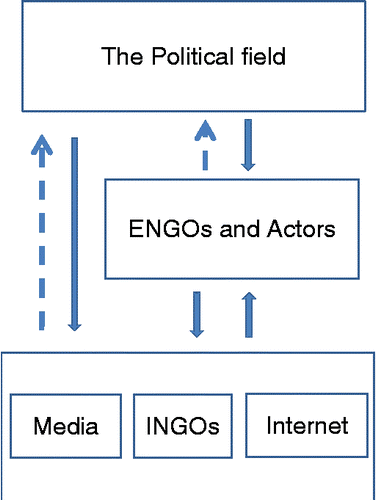
This point is further reinforced by a survey conducted by Phillip Stalley and Dongning Yang (Citation2006) of university students in Beijing.Footnote11 While these students demonstrate a high degree of awareness of environmental issues, even compared to their international counterparts, their views are not framed in terms of the need for contentious collective action. As Stalley and Yang conclude, “At least in the environmental arena, the boundary between government and non-government, official and non-official seems both less relevant and less clear” (p. 352). Or, as Peter Ho (Citation2001) puts it: “An organization that appears to be a government-organized NGO or a public interest lobby working from within the bureaucracy, can sometimes make successful use of civic participation and community action to achieve its aims. Contrarily, grassroots organizations—in particular in the Chinese political context—are dependent on the recognition of the state, and therefore seek to strengthen their contacts with government officials” (p. 911).
An excellent example of this blurring of boundaries in the Foshan context is the “Releasing of Life” ceremony held along the banks of the Fenjiang River in May 2010.Footnote12 The centerpiece of the event was a ceremony whereby Buddhist monks performed ceremonial rites celebrating the re-introduction of fish into a formerly polluted section of the Fenjiang River. This event shares many features of the dragon-boat race, with interwoven threads of local government initiative, civil action, environmental awareness campaigning, and a living expression of enduring Chinese traditional cultural values. Although the official organizer of the event was the local Buddhist community, the Fenjiang River Comprehensive Remediation Office was actively involved in the preparations.
Returning again to Gaobing Yang's field perspective (see Figure ), it is also useful to assess the role of media, international NGOs and the internet in the evolution of the Fenjiang River comprehensive restoration project. The role of the media in China is, of course, carefully circumscribed by the state, but it would be a mistake to think of it as monolithic and passive. Several authors have pointed to the symbiotic relationship between ENGOs and the media in China, and Elizabeth Economy (Citation2004, p. 138) asserts that “underpinning all environmental activism in China are the Chinese media.” In her view, the vast majority of Chinese people learn about environmental issues from television and radio, and several of the case studies she examines demonstrate that the roots of pioneering ENGO activists lie in progressive media. In the case of Foshan, local media provided extensive local coverage of the dragon-boat races and Releasing of Life ceremonies described above, as well as of the international forum described below. As with ENGOs themselves, these media outlets enjoy a certain autonomy but are generally careful not be to be perceived as oppositional.
The Internet has become an increasingly important locus for environmentalism in China in recent years (Yang, Citation2005; Sullivan & Xie, Citation2009). Not surprisingly, it is the younger generation that is most tuned in to this medium, and attitudes towards environmentalism presumably reflect such influences. An instructive study undertaken by Sullivan and Xie (Citation2009) applies a social network analysis directly to the links between environmental websites in China. Interestingly, their examination of these relationships in cyberspace leads them to a very similar conclusion to that which we have already recognized in the institutional political sphere: “One striking feature of the network is…the blurring of boundaries and amorphous nature of the environmental sphere in China” (p. 430). Again, we see particular evidence of this in the case of Foshan. As part of the research reported here, 20 core environmental websites cited by Sullivan and Xie (Citation2009, Table ) were probed to see what information they could generate regarding the Fenjiang River comprehensive remediation project, with a view to ascertaining how visible the project was amongst the environmental community in wider China. These websites were identified through social network analysis as exhibiting the highest degree of centrality among environmental websites in China. However, only one of the 20 sites, the website for China's Ministry of Environmental Protection, provided any substantial links to the Foshan case study.Footnote13 If there is an oppositional presence to the Fenjiang River restoration project, it is not an easy one to find, and so it would appear that the default narrative for the project is that which is being advanced by Foshan municipal government.
The final element of Yang's (Citation2005) field perspective on ENGOs in China pertains to international NGOs (INGOs). Here again, at the national level there is a long and interesting history of engagement. As described by Economy (Citation2004), the foundations for environmental protection as a policy priority within China stem in large measure from China's participation in international forums over several decades. Peter Ho's (Citation2001) notion of the “greening of the state” affirms this view of a central government that has increasingly accepted environmental issues as a priority, and has been willing to widen the public discourse on such topics. In the case of Foshan, the World Bank and Foshan Municipality co-sponsored an international forum in 2009 organized by the Pacific Rim Council on Urban Development (PRCUD) to address a wide range of issues pertaining to the Fenjiang River comprehensive remediation project.Footnote14 Mayor Chen YunxianFootnote15 invited 20 international experts (Figure ) to spend several days conducting field trips and participating in focused roundtable discussions with their local counterparts about the Fenjiang River project.Footnote16 In addition to the substance of those discussions, the event was emblematic of the overall positioning of environmental issues within Yang's field perspective, with a distinctive mix of media (including the Internet), INGOs, ENGOs, university students, local experts, and government officials all interacting in a swirl of formal and informal discourse. The municipality's motivation was evidently a desire to learn from best practices and case studies of river restoration projects elsewhere in the world, but also to publicize the Fenjiang River at home and abroad as a significant and groundbreaking intervention.
Urban Rivers with Chinese Characteristics
The basic premise with which we began is that the relationship between a human settlement and its urban riverways is broadly reflective of the historical socio-economic context within which it is situated. As noted, this may be construed as part of something that Woodgate and Redclift (Citation1998) refer to as “socioenvironmental relations” (p. 12). Because the Chinese context is itself so unique, we have focused our inquiry on understanding the human–river relationship in context, using Foshan's Fenjiang River as a case study. Recall that Table , at the outset of this paper, began with an encapsulated view of urban rivers in different eras from a broad historical socio-economic context. It seems clear that none of those three perspectives from Table applies very neatly to the Foshan case. While China still lags behind the West in terms of its overall development trajectory, no-one would argue that a pre-industrial mode of human–river interaction applies in contemporary Chinese cities. Nor could one argue that the Fenjiang River restoration project in any way represents a classical industrial era model; indeed, much of the restoration project entails a wholesale dismantling of an increasingly obsolete industrial presence along the riverfront.
Finally, the third possibility, a post-industrial type model of river restoration, also seems inapplicable to the Chinese context. A key element of this third model of river restoration that is missing in the Foshan case is an independent civil society that calls for and prompts such a transformation. In the West, there is often a palpable sense of entitlement on the part of local citizenry to the amenities such refurbished riverfronts might bring. For example, the Friends of the LA River society is a visible embodiment of a segment of civil society in Los Angeles that campaigns for a range of river-related remediation projects. Hayter (Citation2007, p. 25) reports that, when the future of a key group of properties within the LA River watershed was placed under scrutiny, the relevant public authorities were “immediately besieged by groups with competing agendas.” Likewise, in the case Melbourne's waterfront, Dovey (Citation2005, p. 2) articulates a theme of fluid urban transformation evoking “Deleuzian ideas of a world based in ‘flows of desire’.”
As we have seen in the case of China generally, and Foshan in particular, one would be hard pressed to uncover anything that approximates to a proactive and independent environmental movement that might have prompted local government to undertake such an ambitious river restoration project. This is not to deny the possibility of a rather large latent demand for such amenities within Foshan. Evidence for this can be seen in the voluminous crowds that congregate, especially on weekends, in Zhongshan Park, which is one of the city's most popular and enduring civic assets. It is situated on the banks of the river, and one can easily imagine attractive riverside walkways leading throngs of people to and from the central area. There is a subtle but important distinction, however, between (i) a substantial but inchoate and latent demand by the local population for riverfront amenities and (ii) an active civil society that independently formulates a call for such an amenity as a perceived entitlement. In the case of Foshan, it would appear that it is the municipal government itself that is the primary advocate for such change.
Indeed, in a sense, the local government in Foshan is engaged in a kind of “shadow boxing”; that is, it is responding or reacting to the demands of a civic society that has not yet fully emerged. This mode of “anticipatory responsiveness” on the part of local government need not be a bad thing. It is in this context that Yang and Calhoun (Citation2007, p. 212) argue that environmental discourse in China “is distinctive because it engages politics and public policy without being primarily political.”Footnote17 They point to the cancellation in 2004 of a hydropower project on the Nu River as a significant example of effective advocacy within a growing “green public sphere” in China. They may well be correct, but there remains an important distinction between a public response against an ill-conceived project versus the articulation of and advocacy for a particular vision. In regards to Foshan's Fenjiang River restoration project, neither case would appear to apply. In this context, the Fenjiang River project becomes a de facto training ground for public discourse to evolve.
The fact that such a discourse is government-led need not disqualify its legitimacy out of hand. What one sees emerging in such cases is perhaps best understood as professional discourse in lieu of, or, as a precursor to, civic discourse. This phenomenon is increasingly evident at national professional planning conferences within China, where much of the discussion and debate within professional and scholarly planning circles expresses an earnest desire on the part of participants to forge a kind of professional code of practice that is relevant to China's unique circumstances (Leaf & Hou, Citation2006). Such discussions have prompted open debates within these professional venues around three main questions: (i) What is the public interest that is being served through urban planning and development initiatives? (ii) By what means are planners to infer such interests? And (iii) how are those inferences to be translated into planning practice? Such questions are no less compelling in the Western context, but the answers may well vary with the circumstances under which they are posed.
By way of summary, Table encapsulates the analysis from this paper into a “bottom line” that is comparable to the earlier presentation in Table . It can be thought of as the addition of a new column to that table, contrasting urban rivers in contemporary China with those in other eras or contexts. Recall that in Table , the human–river relationship was characterized as being viewed in “fundamentally ecological”, “starkly utilitarian”, and “increasingly aesthetic” terms for each successive era. In the case of China, based on the Foshan case study, Table characterizes this human–river relationship in terms of China's quest for modernization.Footnote18 As discussed in the pages above, the Fenjiang River remediation project is an integral part of a broader political imperative within China to modernize. This larger project is, in turn, posited as an undertaking rooted in scientific rationality and expertise. Such a perspective seeks to see measurable progress towards these modernization goals. River remediation projects are highly conducive to this benchmarking, evaluative approach, with much emphasis placed on technical data regarding water quality, industrial composition, land-use disposition, economic output, and other overtly measurable outcomes. In one sense at least, the rivers themselves are quite incidental to the larger enterprise, as they happen to provide a convenient entry point for urban redevelopment interventions.
Table 2. Urban rivers in the Chinese context based on Foshan case study
Recall that Table characterized those respective eras in terms of (i) sustainable practices inculcated and reinforced by social traditions and human cultures; (ii) industrial practices shaped by market forces and mechanisms; and (iii) land-use practices formed through political processes and civic engagement. In the case of China we now add (iv) nascent civil discourses interpolated by professional practices and traditional values. In a sense, the traditional values (as embodied, most notably, in the evocation of Foshan's “Mother River”) serve as a kind of proxy for civil society. It has often been remarked that the Cultural Revolution effectively undermined long established norms of civility within Chinese society, and that ideological fervor proved to be a poor substitute. Professional expertise, or principles of scientific rationality, can fill the lingering void only partially, and so traditional values are a valuable backstop. They retain an enduring presence in Chinese society, and they implicitly call forth a civil society that adheres to those same values. This intrinsic tension between professionalism in urban planning and adherence to traditional Confucian values has been explored at some length by Heikkila and Griffin (Citation1995) and Leaf (Citation2005) among others. Urban river restoration in China can be understood fully only within this deeper context. It is indeed truly distinctive; it is in essence environmentalism with Chinese characteristics.
Acknowledgements
This paper was partly prepared in conjunction with the 2009 PRCUD Roundtable Forum in Foshan, China. However, the views expressed herein are solely those of the author, and may not be ascribed to PRCUD, Foshan Municipality or any other persons or institutions affiliated with the Forum. The author is grateful to Raabia Budhwani, Eunok Im and Jingjie Ginger Li for research assistance, and to the editors of this journal and three anonymous referees for constructive suggestions for improving upon an earlier draft.
Notes
1. In 2008, Foshan's per capita GNP was 72,975 RMB, compared to 22,698 RMB for China as a whole. Data from the websites of the Foshan and National statistical bureaus, respectively.
2. One indication of Foshan's importance as an exemplar is that the World Bank Institute has incorporated it as a case study for the purposes of its own instructional materials of best practices on urban riverfront redevelopment. See http://vle.worldbank.org/moodle/course/view.php?id = 362. Those materials in turn were drawn from work reported on in this paper.
3. Although Foshan is an exemplary case study in the Chinese context, it is not alone in this regard. See, for example, the description by Zhong and Zhou (Citation2009) of the Suzhou Creek revitalization project in Shanghai.
4. The term “in-fluence” is especially apt here.
5. The Foshan component of the project loan for the second tranche of funding for this Pearl River delta water quality project (PRD2) is US$72 million.
6. Industrial clusters tend to specialize by industry, with major clusters at Shiwan (ceramics), Zhangcha (knitting), Lanshi (stainless steel), Huanshi (children's clothing), Dali (nonferrous metal processing), Yanbu (under garments), Luocun (lighting) and Pingzhou (shoes). See Foshan (Citation2009, vol. V).
7. In a case that caught worldwide attention, a woman in Chongqing refused to cede her property rights despite strong local government pressure for her to do so. All the surrounding buildings had been demolished, leaving the striking image of the “nail house”, so named because of its appearance.
8. The term “nullah” originates from Hindi, and was brought to Hong Kong via British colonial influences. In the Hong Kong context a nullah is typically a concrete-lined storm water drainage channel. Wallace Chang (Citation2009) and others began referring to the former Kai Tak Nullah as the Kai Tak River as a conscious effort to change public perceptions about the relationship between surrounding communities and this waterway.
9. The first environmental NGO, Friends of Nature, was established in 1994 (Economy, 2005). For an overview of growth in Chinese ENGOs over recent years see Yang (Citation2005).
10. This quoted statement by Pye itself contains a contentious premise, as South Korea has somehow evolved in very short order to host one of the world's most vibrant civil societies.
11. University students in Beijing occupy an elite position within their generation, and have long been a kind of bell-weather of emergent socio-political movements in China.
12. The official title of the event is also instructive: “Guangdong Provincial Buddhist Community and Foshan Religious Community Fenjiang River Releasing of Life” ceremony.
13. See http://www.zhb.gov.cn/, which on August 19th, 2010, hosted four articles describing the Fenjiang River Remediation project.
14. The author of this paper was a principal international organizer of the PRCUD Foshan Forum, and that is the genesis for this research.
15. Then-Mayor Chen Yunxian was subsequently promoted to Party Secretary for Foshan Municipality.
16. A summary of the discussions and recommendations of the Foshan forum is available at the PRCUD website http://sites.google.com/site/prcudweb/.
17. Yang and Calhoun point to the cancellation in 2004 of a hydropower project on the Nu River as a significant example of effective advocacy within a “green public sphere” within China.
18. Note that we use the term “modernization” here rather than “modernity”. The latter is the concern of scholars, the former is much more pertinent to the focus of China's political leadership. There is of course considerable interplay between the two concepts.
References
- Bird , E.A.R. 1987 . The social construction of nature: Theoretical approaches to the history of environmental problems . Environmental Review , 11 ( 4 ) : 255 – 264 .
- Bourdieu , P. 2000 . “ Habitus ” . In Habitus: A Sense of Place , Edited by: Hillier , J. and Rooksby , E. Aldershot : Ashgate .
- Chang , W.P.H. 2009 . Rediscovery of Human Landscape: Kai Tak River , Hong Kong School of Architecture, Chinese University of Hong Kong .
- Deininger , K. and Jin , S. 2009 . Securing property rights in transition: Lessons from implementation of China's rural land contracting law . Journal of Economic Behavior and Organization , 70 : 22 – 36 .
- Ding , C. 2007 . Policy and praxis of land acquisition in China . Land Use Policy , 24 : 1 – 13 .
- Dovey , K. 2005 . Fluid City: Transforming Melbourne's Urban Waterfront , London : Routledge .
- Economy , E.C. 2004 . The River Runs Black: The Environmental Challenge to China's Future , Ithaca, NY : Cornell University Press .
- Enright , M.J. and Scott , E.E. 2007 . The Greater Pearl River Delta , 5th edition , Hong Kong : SAR Government . report commissioned by Invest Hong Kong
- Foshan . 2009 . Report on the Fenjiang River Basin , Foshan, Center for Water Resources and Environment of Sun Yatsen University, for the Foshan Fenjiang River Comprehensive Remediation Management Office, Foshan Municipality .
- Hayter , J.A. 2007 . Los Angeles River urban wildlife refuge: A vision for parks, habitat and urban runoff by community development by design . Places , 19 ( 3 ) : 24 – 29 .
- Heikkila , E.J. 2007 . Three questions regarding urbanization in China . Journal of Planning Education and Research , 27 ( 1 ) : 65 – 81 .
- Heikkila , E.J. and Griffin , M. 1995 . Confucian planning or planning confusion? . Journal of Planning Education and Research , 14 ( 4 ) : 269 – 279 .
- Ho , P. 2001 . Greening without conflict? Environmentalism, NGOs and civil society in China . Development and Change , 32 : 893 – 921 .
- Leaf , M. 2005 . “ Modernity Confronts Tradition: Professional planning and local corporatism in the rebuilding of China's cities ” . In Comparative Planning Cultures , Edited by: Sanyal , B. 91 – 111 . London : Routledge .
- Leaf , M. and Hou , L. 2006 . The ‘third spring’ of urban planning in China: The resurrection of professional planning in the post-Mao era . China Information , 20 : 553 – 585 .
- Lin , G.S. 2001 . Metropolitan development in a transitional socialist economy: Spatial restructuring in the Pearl River Delta, China . Urban Studies , 38 ( 3 ) : 383 – 406 .
- Perry , E.J. 1994 . Trends in the study of Chinese politics: State–society relations . China Quarterly , 139 : 704 – 713 .
- Pye , L.W. 1999 . Civility, social capital, and civil society: Three powerful concepts for explaining Asia . Journal of Interdisciplinary History , 29 ( 4 ) : 763 – 782 .
- Shalizi , Z. 2008 . “ Water and urbanization ” . In China Urbanizes: Consequences, Strategies, and Policies , Edited by: Yusuf , S. and Saich , T. 157 – 179 . Washington DC : World Bank .
- Shen , J. , Wong , K. and Feng , Z. 2002 . State-sponsored and spontaneous urbanization in the Pearl River Delta of South China . Urban Geography , 23 ( 7 ) : 674 – 694 .
- Stalley , P. and Yang , D. 2006 . An emerging environmental movement in China? . China Quarterly , 186 : 333 – 356 .
- Sullivan , J. and Xie , L. 2009 . Environmental activism, social networks and the Internet . China Quarterly , 198 : 422 – 432 .
- Tucker , M.E. 1991 . The relevance of Chinese neo-Confucianism for the reverence of nature . Environmental History Review , 15 ( 2 ) : 55 – 69 .
- Woodgate , G. and Redclift , M. 1998 . From a ‘sociology of nature’ to environmental sociology: Beyond social construction . Environmental Values , 7 ( 1 ) : 3 – 24 .
- Yang , G. 2005 . Environmental NGOs and institutional dynamics in China . China Quarterly , 181 : 46 – 66 .
- Yang , G. and Calhoun , C. 2007 . Media, civil society, and the rise of a green public sphere in China . China Information , 21 ( 2 ) : 211 – 236 .
- Yusuf , S. and Nabeshima , K. 2008 . “ Optimizing urban development ” . In China Urbanizes: Consequences, Strategies, and Policies , Edited by: Yusuf , S. and Saich , T. 1 – 41 . Washington DC : World Bank .
- Zhong , S. and Zhou , J. 2009 . Historic conservation and economic development: Are they necessarily rivals?: The case of Suzhou Creek industrial heritage in Shanghai . Planning Theory & Practice , 10 ( 2 ) : 281 – 289 .
